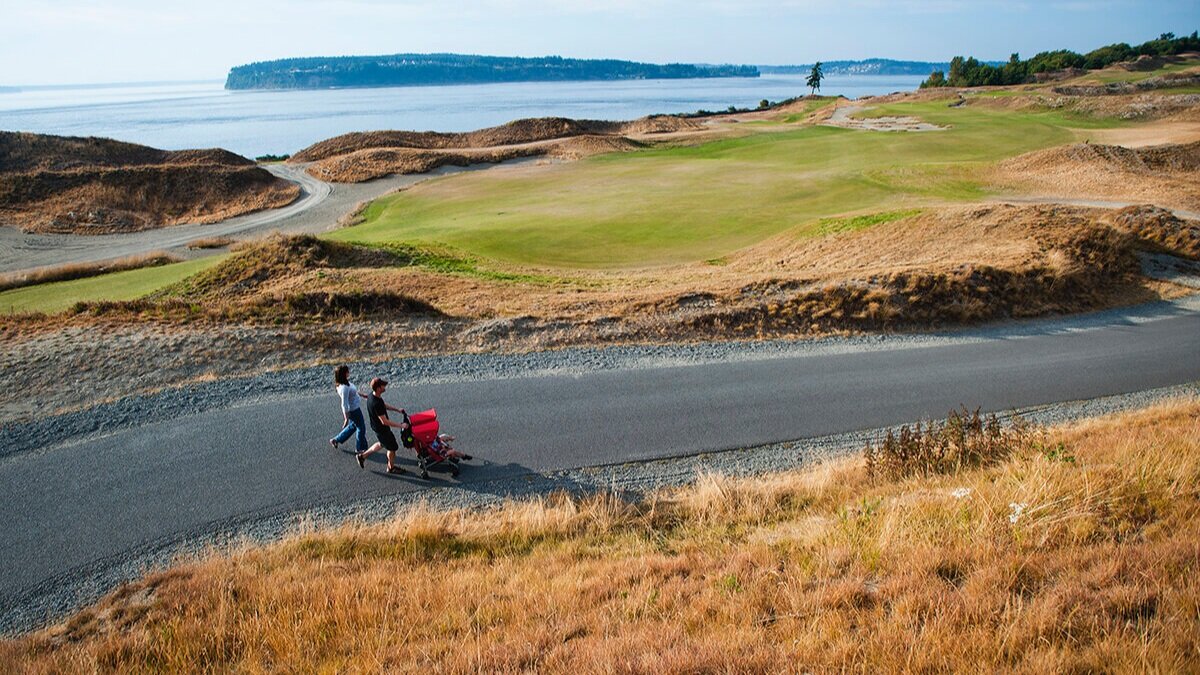Geology
View Historic Photos
Download Geology Article
The fact that Chambers Bay Golf Course was built upon a former gravel mine became pretty well known after the 2015 U.S. Open Championship. But that is only a tiny part of an amazing story of the natural forces that modified the earth and created the landforms of the Chambers Creek Properties. You don't have to be a rock hound or a science geek to appreciate the beauty and wonder of it all, you just need to read a bit more and then come explore the site. If you are interested in the mining of the site, go to our History of the Properties page. Trail and access points mentioned can be found on our Trails page.
Some of the geology story is on display at the Curve Wall Plaza at the corner of 64th St. W. and Grandview Drive W. If you haven't stopped there for even a few minutes, then you should. The very large boulders constructed into the curve wall are beautiful and their journey to this museum level display is pretty amazing. Another part of the story is visible in the Chambers Creek Canyon, while yet another part is found in Chambers Bay itself. Nature has provided us with a unique outdoor setting for wonder and education all in one place! The Foundation and Pierce County have provided the trails, pathways and plazas to access and experience these stories for yourself. We plan to do still more!
Mount Rainier with visible glaciers.
Glaciers
It's not just about glaciers, but it mostly is. Glaciers are massive and centuries-old accumulations of snow and ice that are still readily visible on Mount Rainier today, especially during the summer months. These are just the remnants of the really huge glaciers which covered the Pacific Northwest during the Pleistocene Ice Age; 18,000 to 13,000 years ago. The Chambers Creek Properties are the point where two separate glacial systems intersected. One came from the north in the Canadian Rockies towards the south, carving what is now the Puget Sound. The second coming from the east off the flanks of Mount Rainier and running westward across the width of Pierce County toward Puget Sound. The collision of these two different sources, each with very different characteristics resulted in the geology, land forms, soils and water features we know today.
How'd the gravel get here?
The northern glacier is known as the Vashon Glacier, which covered Puget Sound and the Properties, has been estimated to be about one-half mile in depth (2300-2500 feet). The tremendous weight of this huge mass carved and compacted the land as it moved. Vashon Glacier remained over this area for 1500+ years until it started to recede back to the arctic regions. The softer spots were deep troughs which eventually filled with meltwater into Puget Sound and numerous large lakes. Harder spots are today's islands and uplands.
Much of central and western Pierce County are dominated by these alluvial soils and geology. You can dig up these rounded rocks just about anywhere (Parkland, Spanaway, Lakewood, Graham, etc). As the meltwaters flowed westward, they ran into a sizable and solid ice dam formed along the edge of the harder, deeper, colder, Vashon Glacier. The result is the Chamber Creek Canyon. The melt water continued to cut away the layers of alluvial deposits on the south (Lakewood side of the Creek), while the more porous but much rockier moraines on the north side (University Place side) remained (steeper and closer to the creek edge). When walking the upper Canyon trails, you can really notice these characteristics and the differences (slopes, vegetation, etc.
(C) Julee Rudolf
Alluvial deposit
What's on the other side of the Creek?
The Mount Rainier glaciers were smaller, younger and not as deep as the Vashon Glacier. The moraines are not as substantial and did not reach out this far. Much of Pierce County was covered in surface ice which has more frequent melt cycles and does not grind and crush the land to the same degree as an alpine glacier. During these melt cycles, water runs across the land carrying the smaller stones, gravels, sand and soils. Because of the rolling/washing nature of the melts, the stone tends to be rounded and smooth (like river rock), compared to the sharp edges of ground stone found in moraines. These areas are known as outwash plains, and as the water impounds or has slower flows, the dirt and sand (silts) drop out and settle on the land as it dries. These are known as alluvial deposits. Sometimes the soils are fertile and well suited for growing crops and vegetation. Sometimes the deposited soils are mostly clay, very dense and not as good for growing things.
What's so special about the Bay?
Chambers Bay is a sizable saltwater estuary, and one that has some unique features. As an estuary, fresh water from Chambers Creek, Rock Creek (or no-name) and Garrison Springs flow directly into the Bay, mixing with the salt-water of Puget Sound. Estuaries are extremely important to the water quality of large saltwater bodies, the health and safety of wildlife (and hatchery fish), and are generally the most productive portions of saltwater bodies. Estuaries also serve an important role in reducing tidal flooding issue, but that isn't an issue in Chambers Bay.





